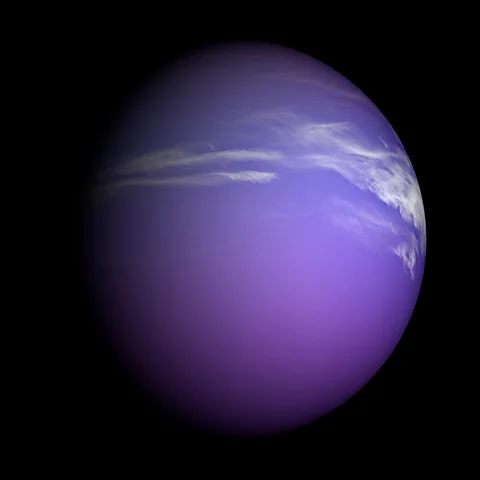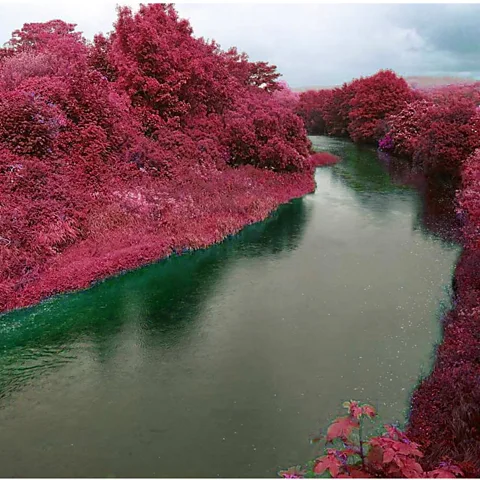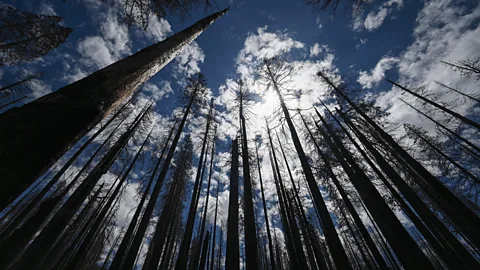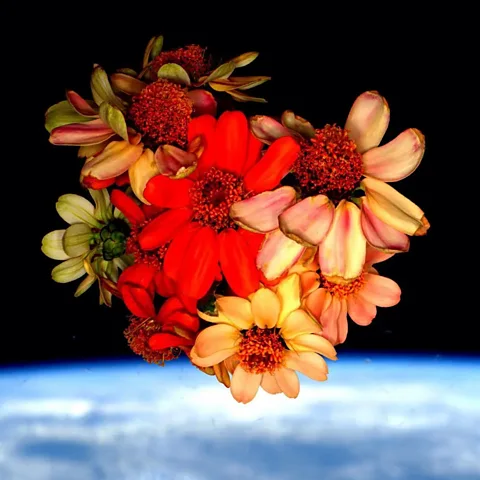The scientists looking for alien vegetation
 Emmanuel Lafont
Emmanuel LafontAlien life could take many different forms, but one possibility is captivating scientists: alien "plants". What would they look like? And how could we find them?
On the Orion arm of the Milky Way galaxy, around 93 million miles (150 million kilometres) from the yellow dwarf star it orbits, is a medium-sized rocky planet. At the edge of a vast southern ocean, are the gently lapping waters of a hot-pink lake. With snow-white, crystalline shores, and more than 38 times the salt concentration of pickled olives, among its sole inhabitants are a kind of obscure life with a striking purple hue. These primitive microorganisms are decidedly alien-like: not quite bacteria, but not exactly like anything else either, they are able to thrive in conditions that seem utterly inhospitable.
This planet is, of course, Earth – and the lake is found on the southern coast of Western Australia. But the purple "halobacteria", which help to ensure the waters of Lake Hillier remain permanently Barbie-pink are also thought to hold clues to finding a certain kind of life on more distant worlds: alien vegetation.
Over the last three decades, astronomers have identified 5,528 planets outside our own solar system – a medley of weird worlds, ranging from one so dark, it's trapped in an eternal night (TrES-2 b), to a poltergeist planet that orbits an undead star (PSR B1257+12 b). And in the not-too-distant future, astronomers are confident that – if there is indeed life beyond Earth – they'll be able to spot the unmistakable signature of extraterrestrial photosynthesis.
Alien plants are expected to be every bit as peculiar as you would imagine: forests of black trees under skies with multiple suns; growths of alien shrubs that all lean in one direction, amid a permanent sunset; carnivorous undergrowth that can swallow up other alien life-forms whole.
A planet of plants
Whether aliens resemble sophisticated jellyfish-beings, three-headed beetles, or they're so unfathomably strange they defy imagination, there are some rules for their biology laid down by physics. And one thing is certain: to resist the irrepressible pull of entropy – which wants to pull living organisms apart, atom-by-atom – they're going to need a source of energy. There are only three known ways to extract this resource from the environment. Extraterrestrials could obtain it directly, trapping it from sunlight, like plants do, or by using inorganic chemicals, like bacteria at hydrothermal vents do. Alternatively, they could take a shortcut – and simply devour another organism that has already done one of those things, like animals do.
 Getty Images
Getty ImagesThis article is part of a week of special coverage about extraterrestrial life – all to mark the upcoming 60th Anniversary of the BBC's most famous alien lifeform, Doctor Who.
On Earth, the vast majority of life – by weight, at least – has run with the first option. It's been estimated that out of the 550 gigatonnes of carbon bound up in living organisms today, 450 gigatonnes are found in vegetation. What if most life in the Universe is photosynthetic? Is it possible that, in fact, our quest for intelligent civilisations has been misguided – and we should have been looking for flora, not fauna, all along?
"We know that on our planet, photosynthesis has been successful since almost the beginning of life," says Nancy Kiang, a biometeorologist at Nasa's Goddard Institute for Space Studies in New York City. "…and it's expected that it could become a successful process on another planet."
However, finding this otherworldly vegetation could prove to be tricky.
A clever experiment
On 8 December 1990, a shiny metallic object skimmed past the Earth and pointed its instruments at us. This was the Galileo spacecraft, and it began taking a series of measurements with an extraordinary goal: to see if there was life on our planet. Then it disappeared into the depths of our Solar System.
The experiment was thought up by the American astronomer Carl Sagan, and the idea was simple – if humanity was encountering the Earth for the first time from space, could we detect unmistakeable signs of life without dropping down for a visit? Galileo sent back data from equipment designed to measure various wavelengths of electromagnetic radiation – such as UV and infra-red light – and revealed some promising signals. These, in turn, can teach us how to find life on more distant worlds.
For one thing, Sagan found that there was an abundance of oxygen, a possible sign that photosynthesis was taking place. The oxygen in the Earth's atmosphere is constantly being removed by geological and chemical processes, so it was thought to be an unambiguous marker of biological activity by plants – if they weren't always producing it, it would get mopped up. However, it now seems that this is not always the case; more recent research has found that empty planets might also sometimes have oxygen. So to be sure that oxygen is being made by plants, we'll need something else.
Another sign of life, as the Galileo spacecraft looked upon planet Earth, was a particular pigment found widely distributed across its surface. That was chlorophyll – again, Sagan had detected signs of vegetation. However, it didn't appear as you might expect. Though plants look obviously green to the human eye, they have another characteristic that is, in fact, more striking – and easier to spot from space. This is the way they absorb a lot of red light, but not infrared. "Plants are very highly reflective in the near infrared," says Kiang. Light in this band of the spectrum just isn't as "delicious" to vegetation – it prefers shorter wavelengths. This rapid change in the wavelengths it absorbs is known as the "red edge".
One way to find plants on alien planets is to simply copy this experiment, and search for a "red edge" on their surfaces. But it might not always be that straightforward. It's thought that land plants evolved around 500 million to 725 million years ago, so the Earth has only been smothered with green vegetation for around a ninth of its history. For the rest of the time, there either was no life or it had different reflective characteristics.
 Nasa/Caltech/T Pyle (SSC
Nasa/Caltech/T Pyle (SSCThis may also be the case on other planets. One possibility is that alien worlds also have light-harvesting organisms with a "red edge" equivalent, but that it happens at other wavelengths. In fact, there's no reason that alien life would need to rely on chlorophyll to capture energy from its star.
Early in the Earth's history, some experts believe that the dominant life may have been halobacteria like those found at Lake Hillier. Around three billion years ago, the entire planet may have been tinged purple by these microorganisms, which capture energy from the Sun using the primitive pigment retinal. This pigment absorbs light at wavelengths that chlorophyll does not – and has its own version of the "red edge".
An uncanny assemblage
Each year, towards the end of September, the vast swathes of birch, aspen and mountain ash forest that surround Lapland in Finland abruptly turn canary-yellow – an arctic autumn spectacle the nation calls "ruska". It's all down to the normal process of deciduous plants losing their chlorophyll as they prepare to hibernate during the winter. But it's thought that the vivid colours that appear across cooler regions of the globe each autumn may provide a glimpse into the striking scenery found on some alien planets all year-round.
There are many different photosynthetic pigments on Earth, which come in a kaleidoscopic palette of colours. But they're not adopted by organisms at random: each works best in a specific range of environmental conditions. So, back in 2007, Kiang asked – could they use this information to predict what plants would look like on other worlds?
Together with colleagues from Nasa, Kiang began by studying the pigments found in Earthly organisms that harvest energy from the Sun – such as bacteria, lichens and plants. Then they combined their findings with their knowledge about the light emitted by certain types of stars.
The scientists extrapolated that there are a few possibilities. On planets orbiting a hotter star than our Sun – one that emits mostly blue light – plants might absorb only this wavelength, and reflect others. These organisms may appear yellow, orange or red – so whole worlds could have surprisingly autumnal colouring. But all this blue light might be too intense. Kiang explains that it's also conceivable photosynthetic aliens would have a waxy blue surface to reflect some back, like some desert plants on Earth.
On the other hand, vegetation that lives near a dimmer, cooler star might attempt to capture all the light it could get, so it's possible it would look black.
A long wait
Though there is no shortage of ideas about how to spot plants on alien worlds, there is a catch. Currently the main way to view Earth-like exoplanets is via "transits" – when they pass between the star they're orbiting and the Earth. This dims the light of their sun slightly, creating a kind of shadow that can then be detected using a telescope. At the moment, it's rare for astronomers to be able to view the light reflected off planets directly – they're simply too far away, and their dim light is usually swamped by the brilliance of their star.
Kiang explains that these limitations are likely to remain for at least the next two decades. The game-changer will be the launch of the Habitable Worlds Observatory, a space telescope that scientists plan to use to take the first direct images of exoplanets. "But we are where we are now… Maybe my students, before they retire, might actually have the opportunity to directly image possibly habitable planets," says Kiang.
 Getty Images
Getty ImagesIn the meantime, there are some workarounds.
One is to analyse the light coming from the planet's star, instead of the light from the planet itself – starlight that has passed through a planet's atmosphere can hint at the chemistry it encountered on the way. Recently, scientists were able to detect signatures that might indicate the presence of life on the planet K2-18b using this method – though it's 1.1 quadrillion km (0.68 quadrillion miles) away.
The trick could also be used to find oxygen, which would hint at photosynthesis. But it's no substitute for the real deal, and can't be used to find the light-capturing pigments that would provide an extra indicator of the presence of alien plants.
Another possibility will be to use the Extremely Large Telescope – currently a half-built frame set atop a remote mountain in the Atacama Desert of northern Chile. This instrument is expected to be ready by 2028, and will capture 13 times more light than any other in operation today. Kiang explains that it probably won't be able to image Earth-like planets directly. However, it should be able to capture some promising planets.
You might also like:
Usually, the most likely planets for harbouring extraterrestrial life, including vegetation, are expected to be between half the size of Earth and one-and-a-half times as large. But it is thought that some "super-Earths" – even ones that occupy lonely corners of space far from their host star – might be surprisingly habitable, with thick atmospheres and around the right amount of gravity to host life.
These strange worlds are around twice as large as the Earth and have up to 10 times more mass. According to one analysis, the planets – which are unlike any in our solar system – may have hydrogen-based atmospheres. If there's extraterrestrial vegetation, it's possible that it might rely on an alien type of photosynthesis, in which the plants "breathe" by taking in methane rather than carbon dioxide.
Even in the absence of images, some planets are already seen as promising.
 Nasa/ Scott Kelly
Nasa/ Scott KellyAround 40 light years from Earth, locked into the orbit of a cool red dwarf star, are seven small rocky worlds. The Trappist-1 solar system is famous for its unusually high number of small rocky planets that may be habitable. "This is a tremendous discovery," says Kiang.
Two of the Trappist-1 planets are in the so-called Goldilocks zone – they're not too close or too far from their star, so they have just the right amount of radiation to host liquid oceans. In fact, these alien worlds have hundreds of times more water than the Earth, so they might resemble blue marbles too. However, if they contain alien plant-life, it might not be easy to discover it. It's thought that they receive too little light for photosynthesis to be as productive as it is on Earth, so they may not have detectable amounts of oxygen in their atmospheres.
If humans do detect extraterrestrial photosynthesis in the near future, it might be happening on planets occupied solely by weird vegetation – but perhaps we will also find other life too. After all, on Earth, there are around 8.7 million different species of plants and animals. What are the chances each habitable exoplanet will just have one or two?
*This article was updated on 30/10/23 to clarify what scientists have extrapolated about plants on exoplanets, based on knowledge about photosynthetic organisms on Earth.
--
If you liked this story, sign up for The Essential List newsletter – a handpicked selection of features, videos and can't-miss news delivered to your inbox every Friday.
